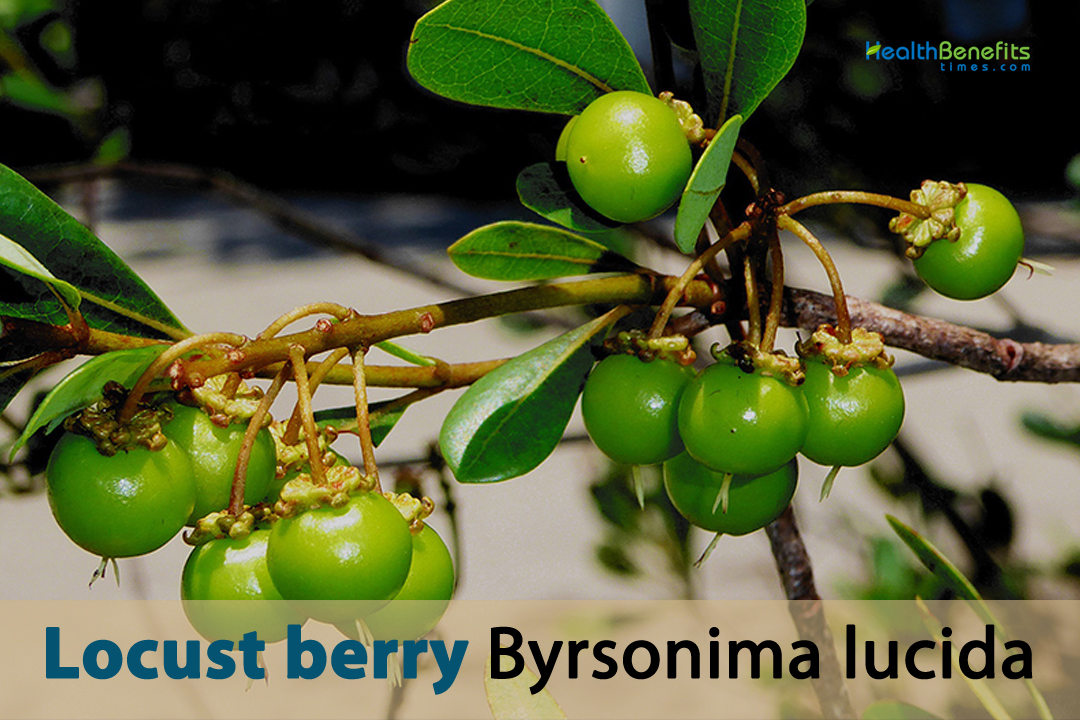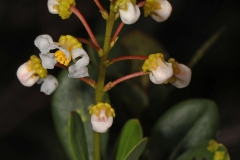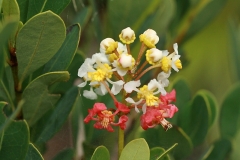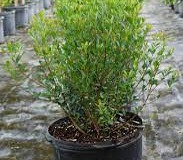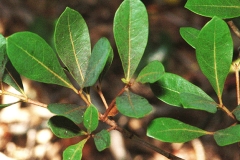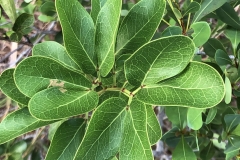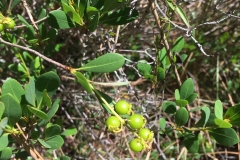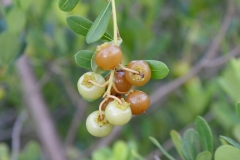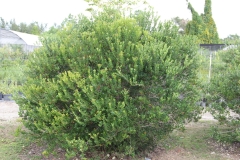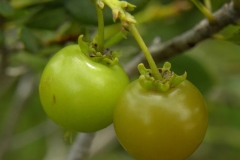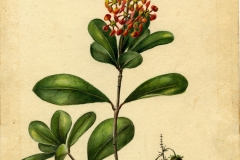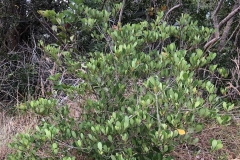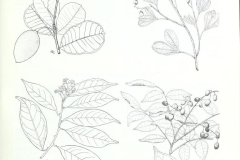The name “Byrsonima” comes from the Greek words “byrsa,” which means “leather,” and “onima,” which means “name” or “mark.” This name probably comes from the way some parts of the plant feel or look, like the leaves or fruit, which might look like leather or have unique marks. For this species, “lucida” is a Latin word that means “shiny,” “bright,” or “glossy.” This word is often used in botanical names to describe how a part of a plant, like leaves, looks. More than likely, it refers to the glossy or shiny leaves of the Byrsonima lucida tree. Native Americans in North America have used different parts of the locust berry plant for food and medicine for a long time. People used the berries to add taste and spice to food, and the plant itself was used to make herbal medicines. People from some native cultures and herbalists think that locust berry can help with health problems and have used it to do so. However, modern herbal medicine does not fully support or record this use.
Locust Berry Facts
| Locust berry Quick Facts | |
|---|---|
| Name: | Locust berry |
| Scientific Name: | Byrsonima lucida |
| Origin | Southern United States, Mexico, Central America, and South America |
| Colors | Initially green turning to red to orange as they mature |
| Shapes | Small, round, colorful drupe, ranging from about 0.2 to 0.5 inches (0.5 to 1.3 cm) in diameter |
| Flesh colors | Juicy and somewhat pulpy |
| Taste | Sweet and somewhat tart |
| Major nutrients | • Antioxidants • Vitamins • Dietary Fibers |
| Health benefits | Heart Health, Digestive Health, Weight Management, Skin Health, Immune Support, Diabetes Management, Respiratory Health, Liver Health, Eye Health, Bone Health, Hormonal Balance, Hair Health |
| Name | Locust berry |
|---|---|
| Scientific Name | Byrsonima lucida |
| Native | Various parts of the southern United States, Mexico, Central America, and South America |
| Common Names | Sweet Haw, Kingwood, Stagbush, Blue Haw, Wild Raisin, Sheepberry, Black Haw, Southern Black Haw, Wapato, Rusty Black Haw, False Banana, Indian Arrowwood, Appalachian Tea, Nannyberry, Hog Plum, Sloe, Nanny Plum, Arrowwood, Stagberry, Western Black Haw, Wild Plum, Smooth Black Haw, American Sloe, Sweet Haw Viburnum, Southern Arrowwood |
| Name in Other Languages | Albanian: Karroba Arabic: Shajirat al-Halibah (شجيرة الحليبة) Armenian: jrɑmɑtsux arǰɑnɑk (ջրամածուխ արջանակ) Assamese: Budu (বুদু) Azerbaijani: şaxdərəxanı yarpaqlı Belarusian: Kalina slivalistaya (Каліна сливалістая) Bengali: Gachera nam (গাছের নাম), Beri’r nam (বেরির নাম), Pintu (পিংটু) Bhili: Khejdu (खेजड़ू) Bosnian: Rogac Bulgarian: Hlebno darvo (Хлебно дърво), Rozhdenden khlyab (Рожденден хляб), Slivolisten viburnum (Сливолистен вибурнум) Chhattisgarhi: Baraiyan (बरईयां) Chinese: Yīng yè jiá mí (樱叶荚蒾), Lǐ yè jiá mí (李叶荚蒾) Croatian: Slivo-listi trn Czech: Kalina švestkolístá, Rogač obecný Danish: Blommesnørbær, Johannesbrødtræ Dogri: Babru (बबरू) Dutch: Sneeuwbalbladige Sleedoorn, Pruimbladige Sneeuwbal English: Key byrsonima, Long Key locustberry, Maricao Cimarron, Clam-cherry, Gooseberry, Locustberry, Shiny locustberry, guana berry Estonian: Ploomilehine lumeroos, Kaarobipuu Filipino: Puno ng algarrobo Finnish: Luumulehtiviburnum, Johannesleipäpuu French: Viorne à feuilles de prunier, Olivier, Longue clé locustberry, Locustberry brillante Garhwali: Phaadadu (फाडादु) Georgian: Tsq’vilsamt’liskverchkhi (წყვილსამთლის კვერცხი) German: Schneeballblättrige Schlehe Gondi: Bedak (बेडक) Greek: Viburnum me fýlla damaskinías (Viburnum με φύλλα δαμασκηνιάς) Gujarati: Nāma nāma (નામ નામ) Hebrew: Tamar ali sel’a (תמר עלי סלע) Hindi: Berry ka naam (बेरी का नाम), (Akad (अकाद) Hungarian: Kajszilevelű galagonya, Johanneskenyérfa Icelandic: Johannesbrauðtré Indonesian: Pohon coklat Irish: Crann cluasaigh Italian: Viburno a foglie di prugna, Viburno prugnoloide Japanese: Puruniforiumu suītovu~aibān (プルニフォリウムスイートヴァイバーン), Puruniforiumu vaibān (プルニフォリウムヴァイバーン), Birusonima rushiida (ビルソニマ ルシーダ) Kannada: Hesaru hesaru (ಹೆಸರು ಹೆಸರು) Karbi: Siklum Kashmiri: Akad (آکڑ) Khasi: Soh Mer Kokborok: Tobu (তোবু) Konkani: Akar (अकर) Korean: Golpulnamu (골풀나무) Korku: Bilav (बिलव) Kumaoni: Babru (बबरू), Baru (बरू) Kutchi: Kungari (કુંગરી), Kadvo Kambaro (કડવો કંબરો), Khedu (ખેડું) Ladakhi: Lor (ལོར) Latvian: Plūmju lapu kalnroze, Maizes koks Lithuanian: Liepžiedžių kalian, Džiovinta duona Macedonian: Rogach (Рогач) Maithili: Kadamb (कदम्ब) Malay: Pokok gondorukem, Pokok Pisang Pis Malayalam: Pēru pēru (പേരു പേരു) Maldivian: Meema (މެމެ) Manipuri: Kaming (কামিংগ) Marathi: Nāva nāva (नाव नाव) Meitei: Thawa (থৌযা) Mizo: Paithar Nepali: Locust Berry (लोकस्ट बेरी) Nagpuri: Khejdu (खेजड़ू) Nicobarese: Maléw Norwegian: Plommebladet snebær Oriya: Akada (ଆକଡ) Persian: Khormachub (خرماچوب) Polish: Kalina śliwolistna, Drzewo chlebowe Portuguese: Viburno de folha de ameixeira, Viburno-prunóide Punjabi: Baīrī dā nāma (ਬੈਰੀ ਦਾ ਨਾਮ), Bel (ਬੇਲ) Rajasthani: Akad (अकड़) Romanian: Vișin de pădure cu frunze de prun, Vânăt cu frunze de prun Russian: Kalina slivovidnaya (Калина сливовидная), Birsonima kuneata (Бирсонима кунеата) Sanskrit: Agnisanghatta (अग्निसंघट्ट) Santhali: Ito (इतो) Scottish Gaelic: Craobh carob Serbian: Šljivovolista bodljika (Шљивоволиста бодљика), Rožnjak (Рожњак) Sindhi: Akar (اکر), Chobhara (چوبهرا) Sinhala: Namak nama (නමක් නම) Slovak: Kalina slivkolistá, Rogač obyčajný Slovenian: Slivovolistni kalin, Karobno drevo Spanish: Viburno de hoja de ciruelo, Espino aligustre, palo doncella, murici, sangre de doncella Swahili: Mzabibu wa damu majani, Mshale wa jani Swedish: Slånbladig snöbär, Johannesbröd Tamil: Peyar peyar (பெயர் பெயர்) Telugu: Pēru pēru (పేరు పేరు) Thai: Ton khanoon (ต้นขนุน), Phêūch bị mạ̀h̄ād (พืชใบมะหาด) Toda: Irampu (ைறம்) Tulu: Kukkiri (ಕುಕ್ಕಿರಿ), Kaadabaalu (ಕಾಡಬಾಳು) Turkish: Gül yapraklı kuşburnu Ukrainian: Khlibne derevo (Хлібне дерево) Urdu: Berry ka naam (بیری کا نام), Beel (بیل) Ukrainian: Kalyna slivolysta (Калина сливолиста) Vietnamese: Cây bàng lá mận, Cây sâm ba khía Welsh: Coeden garob |
| Plant Growth Habit | Wide-spreading, semi deciduous, large shrub or a small tree |
| Growing Climates | Dry forests, savannas, woodlands, primary and secondary rain forest, ridge and savannah forests, shrub lands, coppice, palm woodlands, stream banks, near fresh water areas, damp, shaded areas, human disturbed habitats |
| Soil | Moist, well-drained limestone soils, with or without humusy top layer |
| Plant Size | 20 to 50 feet (6 to 15 meters) tall and 20 to 30 feet (6 to 9 meters) or more wide |
| Root | Taproot grows downward into the soil and serves as the initial anchor for the plant |
| Stem | Stem is woody and serves as the main structural support for the branches, leaves, flowers, and fruit |
| Bark | Smooth, gray to light brown in color when young turning to rougher and develop shallow fissures and cracks as they mature |
| Leaf | Simple, alternate, dark green, glossy, and oval to lance-shaped about 1 to 3 inches (2.5 to 7.5 cm) in length |
| Flowering season | May or June |
| Flower | The plant produces small, around 0.5 to 1 inch (1.3 to 2.5 cm) in diameter, inconspicuous greenish-yellow flowers. These flowers have five petals and are borne in clusters |
| Fruit Shape & Size | Small, round, colorful drupe, ranging from about 0.2 to 0.5 inches (0.5 to 1.3 cm) in diameter |
| Fruit Color | Initially green turning to red to orange as they mature |
| Skin | Relatively thin |
| Fruit Weight | Between 0.1 to 0.2 ounces (3 to 6 grams) |
| Flesh | Juicy and somewhat pulpy |
| Seed | Small, hard, and typically elongated or oval in shape. They are dark brown to black in color |
| Flavor/Aroma | Not strongly scented |
| Taste | Sweet and somewhat tart |
| Plant Parts Used | Leaves, Bark, Roots |
| Propagation | By seed, stem cutting and Air Layering |
| Lifespan | For 20 to 50 years or more |
| Season | July or August |
| Varieties |
|
| Major Nutrition |
|
| Health Benefits |
|
| Available Forms |
|
Plant Description
Locust berry is a large, spreading shrub or small tree that loses some of its leaves in the fall. It usually gets to be 20 to 50 feet (6 to 15 meters) tall and 20 to 30 feet (6 to 9 meters) wide. It has a thick, uneven crown that is either round or flat on top. The stem is also short, with many branches that grow upwards and thin, pale brown bark. It’s interesting that epiphytes can live on the bark. The plant grows in dry forests, savannas, woods, ridge and savannah forests, shrub lands, coppice, palm woodlands, stream banks, areas near fresh water, damp, shady places, and places where people have changed the environment. The soil should drain well and be slightly acidic to slightly alkaline. This plant does best in soft or loamy soil that drains well.
The locust berry is important to its environment because it feeds many animals, such as birds and mammals. It gives animals a place to live and food to eat. The plant’s ability to survive in dry circumstances and its ability to fix nitrogen can change the fertility of the soil and the way ecosystems work. It is sometimes used in landscaping and gardening because its leaves and flowers look nice and can be used as decorations. The wood has been used to make furniture and other crafts in some places. It’s also important to the culture of some native groups.
Appropriate growing environments for Locust berry
Locust berry is a tropical and subtropical plant known for its attractive foliage and small, yellow flowers. If you want to cultivate Locust berry, you should provide it with an appropriate growing environment that mimics its natural habitat. Here are the key factors to consider:
- Climate: The locust berry does best in warm tropical and subtropical places. It’s not good for places where it gets frosty or stays cold for a long time. It does best in USDA hardiness zones 10 through 11.
- Sunlight: The licorice berry plant does best in full to partial sun. Every day, they should get at least six hours of direct sunlight. If you plant them somewhere, make sure they get enough sunshine without being in the harsh, baking afternoon sun.
- Soil: A soil with a pH of 6.0 to 7.5 should drain well and be slightly acidic to slightly alkaline. This plant does best in soft or loamy soil that drains well. Root rot can be avoided by making sure the soil drains well.
- Watering: It is best for these plants to have steady watering, especially when they are growing. They need regular watering to keep the soil fairly moist, but don’t give them too much water or the roots will rot. Do not water the top inch of earth for a while. Let it dry out.
- Fertilization: Locust berry will grow better if you use a balanced, slow-release fertilizer on it in the spring and summer. Don’t fertilize too much because it can cause plants to grow too many leaves instead of flowers.
- Pruning: As needed, prune your locust berry tree to keep its shape and size. To improve the health of the plant as a whole, you can also cut off any parts that are dead or sick.
- Pests and Diseases: Watch out for aphids, scale insects, mealy bugs, and other common pests, as well as fungal diseases. Use the right pesticides or fungicides right away to get rid of any insects or diseases.
- Mulching: Put mulch around the base of the plant to help keep the dirt moist and keep weeds from growing. Mulch can also help keep the ground at the right temperature.
- Container Growing: If you live somewhere where winters are cold, you might want to grow locust berry in a pot. This lets you bring the plant inside during the winter to keep it safe from frost.
- Propagation: You can grow locust berries from seeds or stems. To get more seeds to sprout, soak them and make small cuts on them before planting. In the spring, you can take softwood stems and root them in potting mix that drains well.
Roots
The locust berry starts out as a main root, which is also called a taproot. For the plant, this main root goes deep into the ground and acts as its first support. During the early stages of growth, it also helps the plant take in water and nutrients. When the locust berry gets older, it usually grows a network of secondary roots. After splitting off from the main root, these roots go across and up and down in the dirt. The plant’s secondary roots take in water and nutrients from the earth and also give the plant extra support.
Root hairs are very small extensions that look like hairs and grow from the surface of the secondary roots. These root hairs make the roots’ surface area much bigger, which makes it easier for them to take in water and nutrients from the dirt. A defensive structure called the root cap goes over the bottom of the main root. The root cap helps the root push through the ground as it grows. It also helps keep the growth tip from getting hurt.
Stem
The main, woody stem in the middle of the locust berry tree is called the primary stem, which is also sometimes called the trunk. It connects the plant’s main growth line and supports the whole thing. The vascular tissues that carry water and food from the roots to the rest of the plant are also found in the stem. There are branches that grow out from the trunk and go in different ways. The flowers, leaves, and fruit on these trees are all moving. For plants to get the most sunlight for photosynthesis, branching is an important tactic.
There are vascular cells, such as xylem and phloem, inside the stem. Water and minerals are sent from the roots to the rest of the plant by xylem. Nutrients made in photosynthesis are sent from the leaves to other parts of the plant by phloem. The cortex is a part of the stem that has parenchyma cells and surrounds the vascular organs. Some of the things that the cortex does are store carbs and give the stem some structural support. The stem mostly grows at the tips of the branches and at the nodes, which are the places where new leaves or branches appear. The plant can grow taller and make more leaves because of this apical growth.
Bark
When it comes to Byrsonima lucida, the bark can look different based on how old the tree is. Most of the time, the bark on young trees is smooth and gray to light brown. The bark can get rougher and get small cracks and splits as the tree ages. It feels hard when you touch it, and the surface may be a little rough, especially on older trees. The texture of the bark protects against many things in the surroundings. In some native and ancient ways of life, the bark of the locust berry has been used for different things. Individuals have used it for medical reasons and to get tannins for the purpose of dying and coloring. Different cultures and areas may have different ways of using them.
Leaves
Most locust berry leaves are shiny and dark green. They are circular to lance-shaped or long and have a pointy end. These leaves are simple, which means they only have one leaf blade and aren’t split into lobes. Along the branches of the tree, the leaves are grouped in a pattern of back and forth. In other words, they are placed one after the other along the stem instead of across from each other. Locust berry leaves come in a range of sizes, but most are small to medium, measuring between 1 and 3 inches (2.5 to 7.5 cm) in length. The length of the leaves is equal to their width. The leaves have a clear network of veins, with several main veins breaking off from a midrib in the middle. This arrangement of veins is typical of dicotyledonous plants.
Flowers
The flowers of locust berries grow in groups, which are called inflorescences. These flower clusters can look like pendulous racemes, which are long, hanging structures made up of many separate flowers. Each flower is made up of several important parts, such as the calyx is the outermost ring of structures that cover the flower. It is made up of many small, green structures that look like leaves. These are called petals. The sepals help cover the flower bud as it grows. There is a whorl of petals inside the flower called the calyx. These flowers have five small, yellowish-green petals that are sometimes called “inconspicuous” or “unremarkable.”
The flower’s male reproductive parts are called stamens. They are made up of a stalk-like thread and an anther on top. There are many stamens in a flower—usually between 10 and 20—arranged in a circle around the center pistil. It is the female reproductive part of the flower that is called the pistil. It has three parts: the stigma, which is the surface that pollen sticks to, the style, which is a thin stalk that connects the stigma to the ovary, and the ovary, which is the bigger base that holds the ovules that will turn into seeds.
Fruit
The seeds of locust berries are usually pretty small, measuring between 0.2 and 0.5 inches (0.5 to 1.3 cm) across. Their skin is smooth and a little shiny, and they are round. Fruits can be red, orange, or any other color based on how ripe they are. They are green at first, but as they ripen, they change color slowly. People love the fruits’ sweet and sour taste. These foods taste good, so you can eat them either fresh or after being cooked. The skin of the fruit is pretty thin, and the meat inside is juicy and a little pulpy. It has the same feel as other small berries. There are several small, hard seeds inside each fruit. Usually, these seeds are not eaten, and when the fruit is used in cooking, care is taken to remove them.
Seeds
The seeds of locust berries are small, hard, and usually long or oval. They are a dark brown to black color. There are a few seeds inside the pulpy meat of each fruit. The fruit’s juicy, edible part goes all the way around these seeds. In the wild, the seeds are very important for the plant to reproduce. Animals, like birds and mammals, often eat both the seeds and the juicy pulp when they eat the fruit. The seeds can spread to new places when the animals poop them out because they go through their digestive systems. This helps the plant spread to new places.
Varieties of Locust berry
Locust berry or rain tree, is a plant species with several recognized varieties and subspecies. These variations can differ in characteristics such as growth habit, leaf shape, and distribution. Here are some of the notable varieties and subspecies of Locust berry
- Byrsonima lucida var. lucida: This is the standard or most common type of locust nut. The leaves are dark green and shiny, and the flowers are small and bright yellow. The fruits are usually orange to red and have hard seeds inside. This type comes from several countries in Central and South America.
- Byrsonima lucida var. lanuginosa: People sometimes know this variety by the slightly different way its leaves look. It might have leaves that feel more velvety or rough on the back. The exact differences can be different for each group.
- Byrsonima lucida var. heteromera: This type grows in some parts of Mexico and is known for having leaves that are different sizes and shapes. The shape of the leaves can be oval, elliptical, wider, or narrower than the usual type.
- Byrsonima lucida subsp. luzmariae: This type of bird lives in the Yucatan Peninsula in Mexico. It is different because its leaves are smaller and its area is smaller.
- Byrsonima lucida subsp. ferruginea: This subspecies lives in the Caribbean, in places like Cuba and Jamaica. Some people can tell this type apart from others because the hairs on its leaves and stems are rusty or reddish brown.
- Byrsonima lucida subsp. Americana: Parts of Central America and northern South America are home to this type. It is known for having bigger leaves, but the shape and size of its leaves can vary within its range.
Health benefits of Locust berry
Locust berry has been used for various purposes, including traditional medicine. Here are some potential health benefits of locust berry in detail:
1. Rich in Nutrients
You can get a lot of important nutrients from locust berries, like vitamins (like vitamin C and vitamin A), minerals (like potassium and calcium), and fiber. These nutrients are important for your health and well-being as a whole.
2. Antioxidant Properties
Antioxidants like phenolic substances, flavonoids, and carotenoids are found in locust berries. Antioxidants help keep your cells safe from the damage that free radicals do. This can lower your chance of getting chronic diseases and slow down the aging process.
3. Heart Health
Locust berries have fiber, which is good for your heart because it lowers cholesterol and keeps blood pressure in check. Because these foods are high in antioxidants, they may also help protect the heart.
4. Digestive Health
The dietary fiber in locust berries can help your body digest food and keep your digestive system healthy. Fiber keeps you from getting constipated, helps you have normal bowel movements, and can help keep your gut micro biome in balance.
5. Weight Management
Because they are high in fiber, locust berries may help you control your weight by making you feel full and lowering the number of calories you eat. This might help people who are trying to keep their weight steady or lose it.
6. Anti-Inflammatory Effects
Some studies show that locust berries might be able to reduce inflammation. Many long-term diseases are linked to inflammation, so eating foods that reduce inflammation can be good for your health as a whole.
7. Skin Health
Locust berries have vitamin C, which is important for skin health and making collagen. Getting enough vitamin C can help your skin stay healthy and look young.
8. Immune Support
Locust berries contain vitamin C and other antioxidants that can help the immune system by keeping immune cells safe from toxic stress and helping them do their job.
9. Diabetes Management
Some studies show that locust berry juice might be able to help control blood sugar levels. This could be especially helpful for people who already have diabetes or are at risk of getting it.
10. Respiratory Health
People have traditionally drunk locust berry tea to ease the signs of respiratory illnesses like coughs and sore throats. Locust berry tea may help with these symptoms because it has antioxidants and soothing qualities.
11. Anti-Cancer Properties
There are many phytochemicals in locust berries, such as saponins, which have been shown in some tests to possibly help fight cancer. Even though more study needs to be done, these chemicals may stop cancer cells from growing and lower the risk of getting some types of cancer.
12. Liver Health
Locust berry juice has been used in some traditional medicine systems to help keep the liver healthy. Locust berries may help protect the liver from damage and keep it working right because they contain vitamins and may reduce inflammation.
13. Eye Health
The vitamin A in locust berries is very important for keeping your eyes healthy and clear. To keep your eyes healthy and stop you from going blind at night, vitamin A is very important.
14. Bone Health
Minerals like calcium and potassium, which are found in locust nuts, are important for keeping bones strong and healthy. Getting enough calcium is important for keeping diseases like osteoporosis at bay.
15. Anti-Anxiety and Stress Relief
Traditionally, locust berry tea has been used to help people relax and feel less anxious. Although there isn’t a lot of scientific proof in this area, drinking herbal tea and the possible calming effects of locust berry tea may help some people deal with stress.
16. Anti-Aging
Antioxidants, which are found in locust berries, can help fight oxidative stress, a major cause of aging. Eating foods like locust berries that are high in antioxidants on a regular basis may help your skin look better and younger.
17. Hormonal Balance
Locust berry extract has been used for a long time to help women keep their hormones in order. Some women find that taking locust berry supplements helps with the symptoms of hormonal imbalances, like menstrual cycles that don’t come on time. However, more study is needed.
18. Hair Health
Locust berries have many vitamins and minerals that are good for hair growth. Vitamin C is especially important for making collagen, which is needed for hair to grow and stay strong.
19. Anti-Allergic Properties
Some people have said that locust berry extract helped them with their allergy problems. Even though there isn’t a lot of scientific proof, locust berries may help some people with allergies because they may reduce inflammation.
Culinary uses of Locust berry
Locust berries have culinary uses, although they are not as commonly used as some other fruits. Here are some culinary uses of locust berries:
- Jams and Jellies: Because they taste sour, locust berries can be used to make tasty jams and sauces. When you mix them with sugar and pectin, you get a tasty spread that you can put on toast or use as a topping for other foods.
- Syrups: By cooking the berries with sugar and water, you can make locust berry juice. This sauce can be used to add sweetness to drinks like lemonade or cocktails, or it can be drizzled over pancakes, waffles, or ice cream.
- Baking: You can add locust berries to muffins, pies, and cakes, among other baked goods. Because they taste sour, they can give traditional recipes a new twist.
- Desserts: You can put locust berries on top of yogurt, ice cream, or pudding because they are sweet. Their sour taste can go well with these sweet treats.
- Sauces: When locust berries are cooked down, they make a tasty sauce that can go with roasted meats, chicken, or even as a barbecue sauce.
- Fruit Compotes: You can make a tasty fruit compote with locust berries and other fruits like apples or pears. This can be given as a side dish or dessert.
- Salad Dressings: To give your salads a tangy, fruity taste, you can add locust berry puree or sauce to your own salad dressings.
- Beverages: You can make locust berry tea by letting fresh or dried berries soak in hot water. People know that this tea might be good for your health and can be drunk hot or cold.
- Flavoring for Liquors: It is possible to add locust berries to vodka or brandy to make spirits with a unique taste.
- Chutneys: Berry licorice can be used to make chutneys that go well with grilled meats, cheese, or bread. The chutney’s sweet and sour taste can make many foods taste better.
- Vinaigrettes: You can make your own vinaigrettes with locust berry puree or syrup, which gives salads a unique sweet and sour taste.
- Marinades: You can add a sweet and sour taste to meat, chicken, or tofu with locust berry marinades. Before you grill or roast your meal, let it sit in the marinade for a few hours.
- Sorbet and Ice Cream: You can make your own sorbet or ice cream with locust berries, which give frozen treats a cool and sour twist.
- Smoothies: You can add locust berries to smoothies with other fruits, yogurt, or milk to make a tasty and healthy drink.
- Muffin and Pancake Toppings: You can add fresh or dried locust berries to muffin or pancake batter before baking or cooking to make them taste and feel even better.
- Chia Seed Pudding: For a fruity and healthy breakfast or treat, mix locust berry syrup or puree into chia seed pudding.
- Salsa: To make locust berry salsa, chop up locust berries and add things like tomatoes, onions, parsley, and lime juice. With tortilla chips or on top of fish or chicken that has been cooked, this salsa is a great choice.
- Cocktail Garnish: You can add fresh or frozen locust berries to drinks as a garnish that looks good and tastes great as they thaw.
- Flavored Butter: Put the melted butter and locust berry puree in the fridge until the butter gets firm. You can spread this flavored butter on bread or put it on top of grilled veggies.
- Dried Snacks: To make your own dried fruit snacks, dry locust berries. These are tasty on their own, or you can add them to trail mix to make it more interesting.
Different uses of Locust berry
Locust berries have various uses beyond culinary and potential health benefits. Here are different uses of locust berries:
- Wildlife Food: Animals like birds, mice, and deer rely on locust berries as a main source of food. During the fall and winter, when other food sources may be scarce, they provide food for many species.
- Landscaping and Ornamental: The berries come from locust trees, which are also used in gardening and as ornamental trees because they look nice and can grow in a variety of soils. The tree’s branches can shade areas and make parks and gardens look better.
- Erosion Control: Locust trees are useful in places where dirt is likely to wash away because their deep roots help keep the ground stable and stop it from washing away.
- Timber and Wood Products: People value the wood from some types of locust trees, like the black locust (Robinia pseudoacacia), because it doesn’t rot or decay easily. This wood is used to build things, for fence posts, and for outdoor chairs.
- Firewood: Many people choose locust wood for their fires because it burns slowly and has a lot of energy.
- Crafts and Woodworking: Because it is strong and has interesting grain patterns, craftsmen and woodworkers can use locust wood to make furniture, statues, and other decorative items.
- Honey Production: Honeybees are drawn to the nectar that locust tree buds make, and locust honey has a unique taste. People who keep bees often put their homes near locust trees so that they can make this popular honey.
- Natural Dyes: In the past, locust berries were used to make natural colors that turned clothes red, pink, and purple. The berries are usually crushed and boiled before they are dyed.
- Traditional and Cultural Uses: In some Indigenous tribes, locust trees and their berries are important for ceremonies and culture. They might be used in ceremonies, stories, or old ways of doing things.
- Soil Improvement: Locust trees add nitrogen to the soil, which makes it better. This process is called nitrogen fixation. Because of this, they are useful for restoring land and planting trees.
- Wild crafting: Locust berries are sometimes collected by wild makers and foragers to use in different crafts, like making natural wreaths and other decorations.
- Natural Insect Repellent: You can make a natural bug spray out of locust nuts. To keep bugs like mosquitoes away, crush the berries and rub them on your face or clothes.
- Animal Forage: Besides being food for wild animals, locust berries can also be fed to tame animals like goats and sheep. Some farmers let their animals graze on locust trees to get extra food.
- Traditional Crafts: In traditional arts and crafts, especially in Indigenous countries, locust berries have been used to make ornaments, jewelry, and beadwork.
- Pottery Glaze: Locust berry juice has been used as a natural dye and glaze in clay and ceramics, giving the finished pieces their own unique colors and finishes.
- Natural Cleaning Products: Saponins, which are found in locust berries, are natural agents that can clean. They can be used to make natural, eco-friendly cleaners for cooking, laundry, and around the house.
- Educational Purposes: Locust trees and berries can be used to teach, for example, about the biology of plants and animals and how local plants have been used in the past.
- Fire Prevention: Locust trees are placed in some places as a firebreak to help stop wildfires from spreading because they don’t catch fire easily.
- Folklore and Cultural Symbolism: In many societies, locust berries and trees have been used in stories, folklore, and as symbols. In some situations, they may stand for toughness, endurance, or other cultural ideals.
Side effects of Locust berry
Locust berries, like many natural foods and herbs, are generally considered safe for most people when consumed in moderation. However, there are some potential side effects and considerations to be aware of:
- Allergic Reactions: Some people may be allergic to locust berries or plants that are linked to them, which can cause skin rashes, itching, or hives. Many people are allergic to Fabaceae plants, like peas and beans. This means that you may be more likely to be allergic to locust berries.
- Digestive Issues: If you eat too many locust berries, you might get digestion problems like diarrhea, stomach cramps, or bloating. This is mostly because they have a lot of fiber, which some people find hard to stomach.
- Interactions with Medications: Before adding locust berries to your diet, you should talk to a doctor or nurse if you are on any medicines or have certain medical conditions. There may be reactions with medicines, especially if you are taking medicines that thin your blood or have certain health problems.
- Dental Health: Like many other tart fruits, locust berries can be acidic, which means that eating too many of them could wear away tooth enamel or make teeth sensitive. To keep your teeth clean, it’s a good idea to rinse your mouth out with water after eating acidic veggies.
- Gastro-esophageal Reflux: Some people who have gastro esophageal reflux disease (GERD) or acid reflux may feel their symptoms get worse after eating acidic foods like locust berries. If you have any of these health problems, you should cut down on your diet.
- Pregnancy and Breastfeeding: Not much is known about whether locust berries are safe to eat while pregnant or nursing. Individuals who are pregnant or nursing should usually be extra careful and talk to a doctor before adding locust berries to their diet.
- Kidney Stones: Locust berries have chemicals in them called oxalates that can make kidney stones more likely in people who are more likely to get them. If you have had kidney stones before or are at risk for getting them, you might want to cut back on foods that are high in oxalate, like locust berries.
References:
https://www.itis.gov/servlet/SingleRpt/SingleRpt?search_topic=TSN&search_value=29264#null
https://gd.eppo.int/taxon/BYSLU
https://en.wikipedia.org/wiki/Byrsonima_lucida
https://www.worldfloraonline.org/taxon/wfo-0000576928
https://www.fnai.org/PDFs/FieldGuides/Byrsonima_lucida.pdf
https://plants.usda.gov/home/plantProfile?symbol=BYLU
https://apg.pir.sa.gov.au/gringlobal/taxon/taxonomydetail?id=312604
https://tropical.theferns.info/viewtropical.php?id=Byrsonima+spicata


